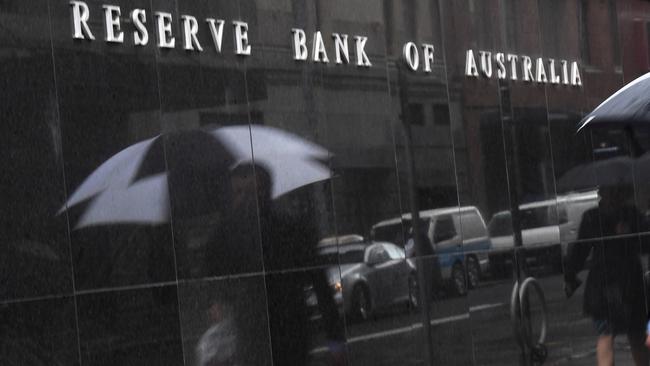RBA keeps door open for another rate rise
The Reserve Bank has given strong hints it’s near the end of its most aggressive monetary policy tightening in decades – but has left the door ajar for another rate increase.

The Reserve Bank has left the door open for another interest rate rise while giving stronger hints that it is near the end of its most aggressive monetary policy tightening in decades.
Minutes from the December board meeting were more hawkish than the decision statement.
The board considered the case for another 25-basis-point increase in the cash rate target – as it has done at every meeting this year – even as it kept the less hawkish guidance on the chance of further rate rises that it adopted after its most recent increase in November.
While the board decided to leave the cash rate unchanged at a 12-year high of 4.35 per cent this month, the minutes again warned that inflation was forecast to stay above target for a “prolonged period” and that that period “could be extended”. It repeated that Australia’s underlying inflation was higher than that of several other countries. Domestic demand remained “above the level consistent with the inflation target and could be supported by a recovery in real household income as inflation fell”.
There were also a couple of hawkish observations that weren’t included in the decision statement. For the first time since last year, the minutes acknowledged that the RBA staff’s most recent forecasts – predicated on a lift in productivity growth – would result in inflation returning to the top of the target band by the end of 2025, “rather than the midpoint of the band”.
“This is the first mention of the midpoint of the inflation target since the start of the aggressive hiking cycle in 2022,” NAB head of market economics Tapas Strickland said.
“It comes after the board has consistently framed and formulated policy as returning inflation to the top of the band.”
The recently signed Statement on the Conduct of Monetary Policy agreed that the RBA board “sets monetary policy such that inflation is expected to return to the midpoint of the target”.

The RBA retains some flexibility as “the appropriate time frame for this depends on economic circumstances and should, where necessary, balance the price stability and full employment objectives of monetary policy”, but the new mandate was relatively hawkish.
The minutes also warned that wages growth risks had “shifted a little to the upside”.
Wages growth “had picked up significantly” over the past year, with the Wage Price Index recording its highest quarterly growth rate since the series began in the late 1990s after the Fair Work Commission’s decision to significantly increase minimum and award wages.
“However, on the evidence available, spillovers to non-award wages did not appear to be larger than usual,” the minutes said. Wages growth was “still consistent” with a forecast peak near 4 per cent by year end, but “members noted that the balance of risks had shifted a little to the upside”.
However, there was “some evidence of slowing wages growth in those parts of the labour market where conditions had eased”. Businesses saw wages growth easing over the year ahead.
Rents declined in October, but “this owed entirely to an increase in Commonwealth Rent Assistance, which offset pressure from very tight rental markets in the capital cities,” the minutes said. Tight rental markets were likely to be “an ongoing source of inflationary pressure for some time”.
NAB sees the RBA lifting rates in February and considers rate cuts next year “unlikely”.
However, board members saw “sufficient value in waiting for further data to assess how the balance of risks was evolving and how best to balance these risks when setting policy”.
“They noted that there had been encouraging signs of progress towards the board’s objectives and that this needed to continue,” the minutes said. “At the time of the meeting, they agreed that inflation expectations remained consistent with the inflation target.”
Businesses “expected price increases to moderate over the coming year, due to subdued demand and stronger competition among retailers”, though many faced “persistent cost pressures”.
Board members said labour market conditions remained tight, but less so than earlier in the year, as the demand for labour had adjusted to slower economic growth and labour supply had increased.
“Forward-looking indicators, such as hiring intentions reported in business surveys and information from the bank’s liaison, pointed to a further easing in the demand for labour in coming months,” they said.
Economic data in November “did not warrant a material revision to the outlook” and showed a “possibility of a larger rise in the unemployment rate than anticipated”.
Growth in household consumption was “expected to have remained subdued in the September quarter” and probably “also remained subdued into the December quarter,” the minutes said.
The increased importance of the November Black Friday sales had distorted usual seasonal spending patterns and would make it hard to get a “clear reading of the underlying momentum”.
Recovering house prices could “support consumer spending in the period ahead” but monetary policy was “working to bring aggregate demand and supply into closer alignment.” Consumption growth was “quite weak, as many households are experiencing a painful squeeze on their finances, with inflation and higher interest rates weighing on real disposable incomes.”
“The pace of disinflation in some other countries over recent months accelerated,” the minutes said. “If emulated in Australia, this would be helpful in bringing inflation back to target.”




To join the conversation, please log in. Don't have an account? Register
Join the conversation, you are commenting as Logout